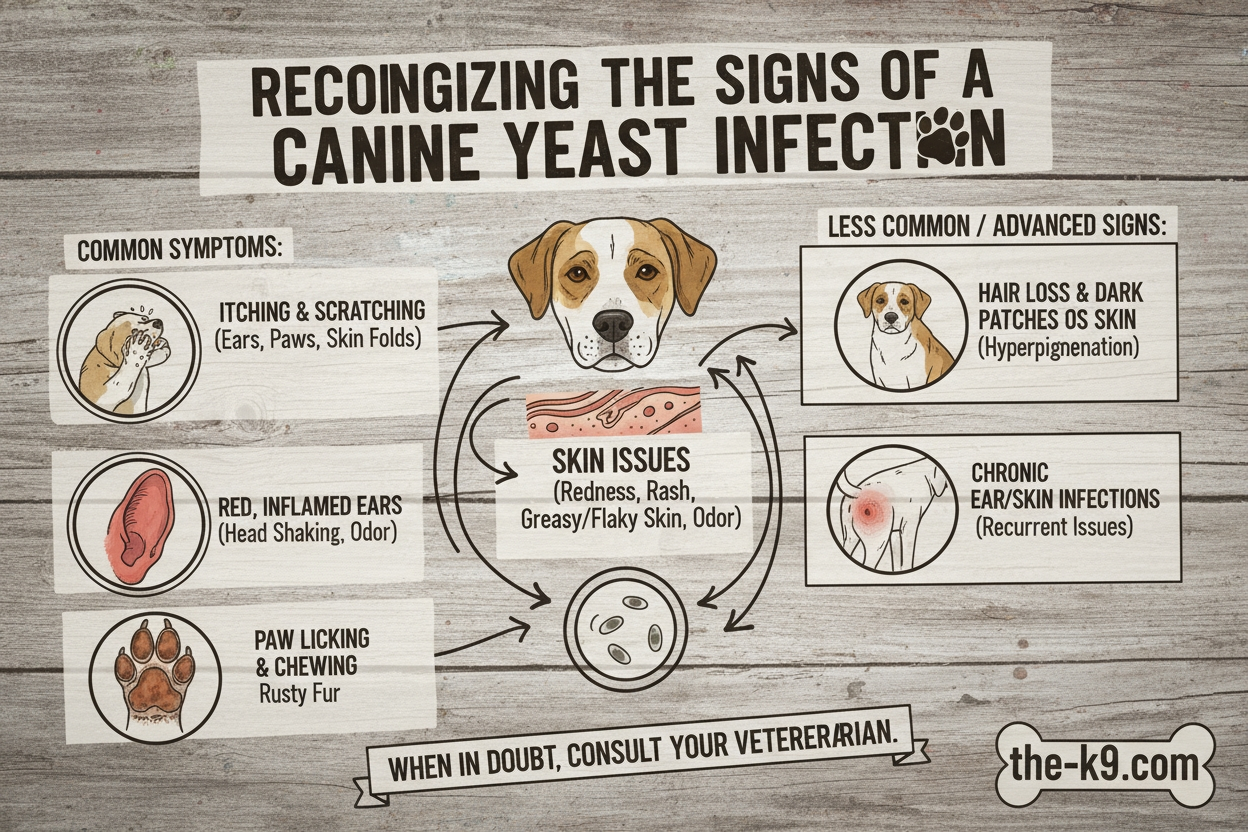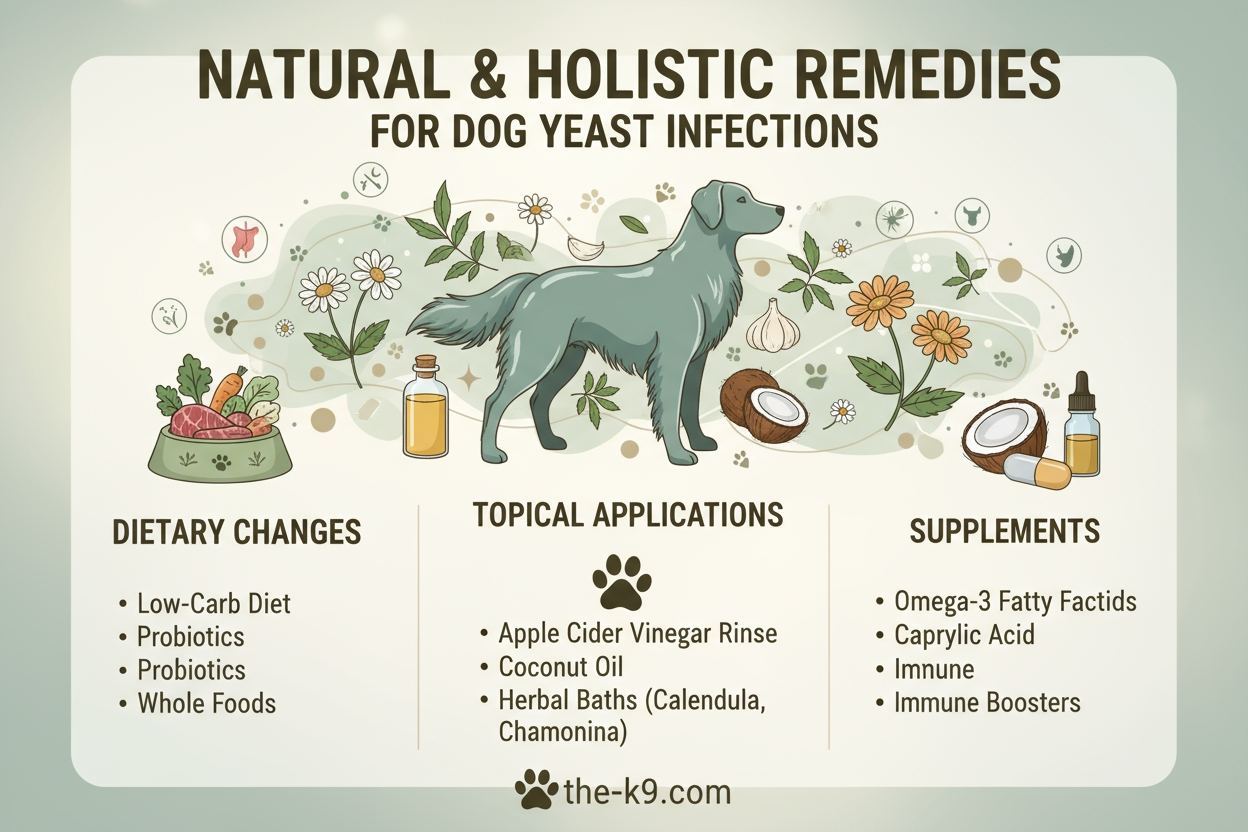Home » Yeast Infections in Dogs: Signs and Treatment Guide


Did you know that Yeast Infections in Dogs are a common issue affecting many canine companions? They cause significant discomfort and distress. These infections thrive in moist environments, like on the skin, in the ears, or in a dog’s face folds.
As a dog owner, knowing the signs and symptoms of yeast infections is key. This guide will help you understand the causes, spot the symptoms, and find treatment options for dog yeast infection treatment.
By learning about yeast infections in dogs, you can help your furry friend feel better. You’ll also know how to prevent it from happening again.
Yeast infections in dogs come from many health and environmental factors. These infections can really hurt a dog’s quality of life. It’s key for pet owners to know the causes and how to manage them.
Yeast overgrowth in dogs often happens when their natural balance is off. This can be due to an underactive immune system or an overactive immune system. Both can lead to yeast infections.
Allergies, like food allergies and environmental allergies, also play a big role. When dogs have allergies, their skin and ears are more likely to get yeast infections.
Yeast infections often hit warm, moist areas. The ears, skin, and paw pads are the most common spots.
| Affected Area | Common Symptoms |
|---|---|
| Ears | Redness, discharge, and a strong odor |
| Skin | Itching, redness, and skin lesions |
| Paw Pads | Redness, swelling, and discharge |
Some breeds are more likely to get yeast infections. Dogs with floppy ears, like Cocker Spaniels and Basset Hounds, are at higher risk. Their ear shape makes it easy for yeast to grow.
Dogs with skin folds are also more likely to get skin yeast infections. Keeping their skin clean and dry can help prevent this.

It’s important for dog owners to know the signs of yeast infections in dogs. This way, they can get help quickly. Yeast infections can show up in different ways, affecting a dog’s body in various ways.
One sign is a change in skin color and texture. The skin might turn red, get inflamed, and feel greasy or flaky. Dogs may also scratch, lick, or chew at the affected areas a lot. This can make the skin even worse and lead to more infections.
Common Symptoms of Yeast Infections in Dogs:
Yeast infections can happen in different places on a dog’s body. For example, ear infections might make dogs shake their heads or scratch their ears a lot. Skin infections can cause redness, inflammation, and a greasy or flaky texture. Paw pad infections can make dogs lick or chew their paws, leading to redness and irritation.
| Area Affected | Common Symptoms |
|---|---|
| Ears | Head shaking, ear scratching, redness, and discharge |
| Skin | Redness, inflammation, greasy or flaky skin, excessive scratching |
| Paw Pads | Licking or chewing at paws, redness, irritation between toes or on paw pads |
If you think your dog might have a yeast infection, see a vet right away. They can figure out what’s wrong and tell you how to help your dog get better.
Yeast infections in dogs can affect different parts of their bodies. It’s important to know the types to treat them right.
These infections can happen in the ears, skin, and paws. Each one has its own signs. Knowing these helps you care for your dog better.
Ear yeast infections are common in dogs. They cause discomfort. Look out for these symptoms:
Ignoring these signs can lead to bigger problems. Regular ear cleaning and inspection can help avoid infections.
Skin yeast infections can be very uncomfortable. They change the skin’s texture and color. Watch for these signs:
A holistic approach to dog yeast infections might include diet changes and topical treatments. These can help symptoms and prevent them from coming back.
Paw pad yeast infections are very painful for dogs. They can make walking hard. Look for these symptoms:
Using natural remedies for yeast infection in dogs can help. Antifungal shampoos and creams are good options.
Knowing the different yeast infections and their symptoms is the first step to treating them. This helps your dog feel better.
Treating yeast infections in dogs often needs a mix of professional help. When a dog gets a yeast infection, a vet will suggest treatments. These depend on how bad the infection is and where it is.
Medicated Baths are a key treatment. These baths use shampoos or conditioners with antifungal ingredients. They help lower the yeast on the dog’s skin. Regular baths also clean off dirt and debris that might cause the infection.
Topical creams and ointments can also help. They are applied directly to the infected areas. They can ease itching and swelling. These treatments work well for infections in specific spots.
For serious or widespread infections, oral medications might be needed. These are antifungal drugs that fight the infection from inside. It’s important to follow the vet’s advice on how to give these medicines. This ensures they work well and don’t cause harm.
| Treatment Option | Description | Benefits |
|---|---|---|
| Medicated Baths | Antifungal shampoos or conditioners used for bathing | Reduces yeast population, removes dirt and debris |
| Topical Creams/Ointments | Applied directly to affected areas | Relieves itching and inflammation, effective for localized infections |
| Oral Medications | Antifungal drugs administered orally | Effective for severe or widespread infections, works systemically |
It’s key to work with a vet to find the right treatment for your dog’s yeast infection. Using professional treatments and good care can help your dog get better. It also helps prevent future infections.

Many pet owners are now using natural and holistic remedies for dog yeast infections. These methods can be used alone or with traditional treatments. They help manage yeast infections.
Making dietary modifications is a key part of natural remedies. A balanced diet rich in nutrients boosts the immune system. It also lowers the risk of yeast overgrowth.
A diet high in protein and low in carbs is good for managing yeast infections. Adding probiotics and prebiotics supports beneficial gut bacteria.
Recommended foods for dogs with yeast infections include:
Avoid foods high in sugar and carbs. They can make yeast infections worse.
Topical natural solutions can also help. They provide relief from itching and inflammation.
Effective topical solutions include:
Supplements and probiotics are also important. Probiotics help beneficial gut bacteria grow. Supplements like omega-3 fatty acids reduce inflammation.
Good supplements for dogs with yeast infections include:
| Supplement | Benefits |
|---|---|
| Omega-3 fatty acids | Reduces inflammation |
| Probiotics | Supports beneficial bacteria |
| Vitamin E | Antioxidant properties |
By using these natural remedies, pet owners can manage yeast infections. This improves their dog’s health.
To stop yeast infections in dogs, keeping things clean and dry is key. Regular grooming is important. Make sure to dry your dog’s ears well, after baths or swims.
Ear-drying solutions can also help. They keep the ears dry and prevent yeast growth.
Don’t let your dog’s area get too wet. Keep it well-ventilated. In humid places, a dehumidifier can help. Clean your dog’s bedding and toys often to cut down on yeast spores.
By doing these things and working with your vet, you can lower the chance of yeast infections. Treating yeast infections in dogs starts with preventing them. A yeast-free environment is a big part of keeping your dog healthy.